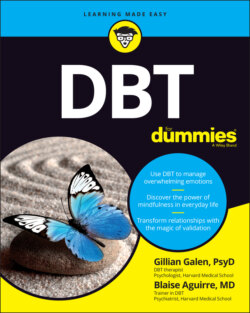Читать книгу DBT For Dummies - Gillian Galen - Страница 44
Accepting Multiple Points of View
ОглавлениеIN THIS CHAPTER
Asking questions about your initial reactions
Widening your perception of other people
Finding compassion for yourself as you look at others
Seeing multiple points of view isn’t always easy, and for some it can, at times, feel nearly impossible. At the foundation of DBT is the concept of dialectics, the idea that two opposing viewpoints can be true at the same time (see Chapter 2 for details) — that is, we can hold multiple points of view or truths. For example, in DBT we wouldn’t necessarily say that the opposite of the truth is always a lie; we would say that the opposite of the truth can be another truth. When you think about it that way, you can begin to open your mind to other points of view, even when you feel very strongly about something.
While people’s thinking can be more or less flexible, one of the things that most strongly gets in the way of seeing another point of view is our own emotions. We know that the more emotional we get, the narrower our thinking becomes. When your thinking narrows, seeing perspectives other than the one you feel most passionate or certain about becomes hard. It can be as if you have tunnel vision.
If you’re someone who feels emotions strongly and intensely, this may be a familiar struggle. Sticking too strongly to your own perspective means you can miss important information, damage relationships, and be less effective at getting what you want or being heard.
In this chapter, you discover how to pay attention and evaluate your first reaction, broaden your awareness to other points of view, and find compassion for yourself as you begin this process.
